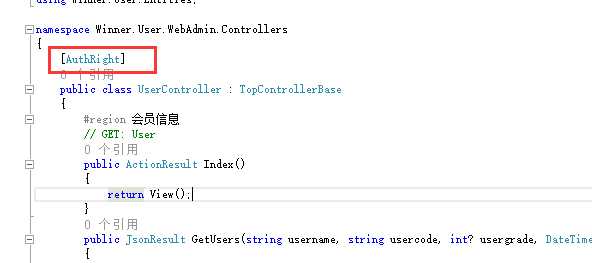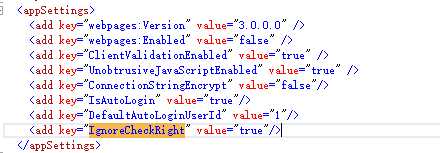标签:clear values eva 对象 获取路径 委托 sql blog status
《核心框架讲解》
核心框架讲解的最后一篇文章,也是第一章最后一篇文章。在.net里,我也不晓得现在有多少团队用的Asp.net 多少用的.net MVC。
其实Winner框架里面是有一套基于Asp.net 写,但是主要宗旨是做两件事: 1,验证是否需要登录,2,验证是否有权限。
额外再封装了一些,弹框,带参数跳转等等一些工具方法。 主要思路是分成了两个基类: TopPageBase 和 CommonPageBase,
TopPageBase 只有前端工具给不需要登录的页面继承的。 CommonPageBase继承了TopPageBase给需要登录并验证权限的界面继承的。
在MVC的时代里,Winner框架的前端做的事情差不多,只是我们采取的方式不同。 首先我们从基类TopPageBase说起:

TopPageBase 做的事情不多,最主要的是提供Json的序列化,也是因为我们MVC主要以json的格式返回。
using System.Collections; using System.Collections.Generic; using System.Data; using System.Text; using System.Web.Mvc; using Winner.Framework.Core.DataAccess; using Winner.Framework.Core.Interface; using Winner.Framework.MVC.Models.Account; using Winner.Framework.Utils.Model; namespace Winner.Framework.MVC.Controllers { // // 摘要: // 所有控制器基类 public class TopControllerBase : Controller { public TopControllerBase(); // // 摘要: // 当前登陆用户信息 protected virtual UserInfo SysUser { get; } // // 摘要: // 返回枚举集合 // // 参数: // all: // 是否支持所有 // // allText: // 如果支持所有则显示的文本 // // 类型参数: // EnumType: // 枚举类型 protected virtual JsonResult EnumsResult<EnumType>(bool all = false, string allText = "=全部="); // // 摘要: // 返回枚举集合Json // // 参数: // allName: // 所有项名称 // // allValue: // 所有项数值 // // 类型参数: // EnumType: // 枚举类型 // // ValueType: // 枚举值类型 protected virtual JsonResult EnumsResult<EnumType, ValueType>(string allName = "", ValueType allValue = default(ValueType)); // // 摘要: // 返回操作失败对象 // // 参数: // message: // 失败原因 protected virtual JsonResult FailResult(string message = ""); // // 摘要: // 返回操作失败对象 // // 参数: // message: // 失败原因 // // code: // 状态码 protected virtual JsonResult FailResult(string message, int code = 0); protected override JsonResult Json(object data, string contentType, Encoding contentEncoding, JsonRequestBehavior behavior); // // 摘要: // 返回Json数据格式(兼容IE、火狐等浏览器) // // 参数: // data: // 需要返回的数据 // // 类型参数: // T: // 需要返回的数据类型 protected virtual JsonResult JsonResult<T>(T data); // // 摘要: // 返回DAL集合对象查询的结果(注意:只用于EasyUI) // // 参数: // dacb: // 集合对象 // // vfp: // 值格式处理委托,为空则不处理 // // 类型参数: // T: // DAL集合对象类型 protected virtual JsonResult ListViewResult<T>(T dacb, ValueFormatProvider vfp = null) where T : DataAccessCollectionCore; // // 摘要: // 退出登陆 protected virtual void Logout(); // // 摘要: // 返回操作成功结果 // // 参数: // content: // 需要返回的数据 protected virtual JsonResult SuccessResult(object content = null); // // 摘要: // 返回DAL集合对象查询的结果 // // 参数: // dacb: // 集合对象 // // vfp: // 值格式处理委托,为空则不处理 // // 类型参数: // T: // DAL集合对象类型 protected virtual JsonResult SuccessResultList<T>(T dacb, ValueFormatProvider vfp = null) where T : DataAccessCollectionCore; // // 参数: // list: // // changePage: // // 类型参数: // T: protected virtual JsonResult SuccessResultList<T>(List<T> list, IChangePage changePage = null); // // 摘要: // 系统代理登陆 // // 参数: // identity: // 用户账户 // // error: // 错误信息 // // 类型参数: // T: // 用户身份类型 protected virtual FuncResult SysProxyLogin<T>(T identity); // // 摘要: // DataTable 对象 转换为Dictionary字典类型的ArrayList // // 参数: // dt: // DataTable // // vfp: // 值格式处理委托 protected virtual ArrayList ToArrayList(DataTable dt, ValueFormatProvider vfp = null); } }
这里要 额外说一些:UserInfo 这个对象,当用户登录后,我们框架会帮我们装载一个当前登录用户的对象,这样就方便我们当前用户数据,
比如 登录账户,用户姓名等等。
这里我不群阐述每个JsonResult类型的返回有什么不同,上面都有注释,基本都能看明白,我们下面看一下 如何验证登录和权限的。
在这之前,我需要引用一篇博客园的文章:http://www.cnblogs.com/lxhbky/p/6344813.html
这篇文章写的很详细,Winner也是采用的这种方法,用了特性类来做的验证:
using System; using System.Collections.Generic; using System.Dynamic; using System.Linq; using System.Web; using System.Web.Mvc; using System.Web.Routing; using Winner.Framework.MVC.GlobalContext; using Winner.Framework.Utils.Model; namespace Winner.Framework.MVC { /// <summary> /// 验证身份:检查访问权限 /// </summary> public class AuthRightAttribute : AuthLoginAttribute { /// <summary> /// 实例化一个新的验证对象 /// </summary> /// <param name="ignore">是否忽略检查</param> public AuthRightAttribute(bool ignore = false) : base(ignore) { } /// <summary> /// 权限验证,继承登陆验证 /// </summary> /// <param name="context"></param> protected override bool OnAuthorizationing(AuthorizationContext context) { //1.判断是否登陆成功 if (!base.OnAuthorizationing(context)) { return false; } //2.忽略权限检查 if (GlobalConfig.IgnoreCheckRight) { return true; } //3.如果是Ajax请求则不检查权限 if (base.ContextProvider.IsAjaxRequest && GlobalConfig.IgnoreAjaxRequestCheckRight) { return true; } //4.获取路径,如:/区域/控制器/动作/ string url = string.Empty; if (!string.IsNullOrEmpty(ContextProvider.Area)) { url = "/" + ContextProvider.Area; } url += string.Format("/{0}/{1}/", ContextProvider.Controller, ContextProvider.Action); //5.判断权限 if (!ApplicationContext.HaveRight(ApplicationContext.Current.User.UserId, url)) { //无法跳转到根目录下 //context.Result = new RedirectToRouteResult(new RouteValueDictionary(new { Controller = "Home", action = "Right" })); if (base.ContextProvider.IsAjaxRequest) { OutputResult("此功能未授权,请联系管理员!", -2); } else { //TODO:未测试 指定Default的路由器下的 context.Result = new RedirectToRouteResult("Default", new RouteValueDictionary(new { Controller = "Home", action = "Right" })); } return false; } return true; } } }
控制器之需要打上特性类的标签就可以验证是否等于以及权限。

当然这里我们用到了权限系统 和 SSO 登录系统,后面的篇章中会单独写到这一块。
Winner.Framework.MVC 最重要的两件事就是 验证登录 和 获取权限。
这里额外要讲一个Winner解决的开发中常见的问题:调试免登录模式
其实,这是一个非常简单的功能,但是非常实用,我们一般开发的时候经常从登录开始做起,当然有SSO的话就不需要开发登录。
但是也会遇到,开发其他需要登录的页面的时候,每次都要先登录,我在未接触Winner的时候就有这样过,但是当时不觉得是个问题,
用过Winner之后就知道,这能节省很多开发时间。
以前几乎每次开发中想运行界面看看效果的时候,每次都需要跳到登录页面登录一下,每次都输入很操蛋。 Winner框架中特别针对这个细节
做了一个配置读取:

从Web.Config 中读取,是否检查权限,是否检查有登录,在开发模式下我们就不检查是否有登录,这样开发起来直接运行就行,不用每次都
输入账号,密码。

虽然是个小细节,但是很实用。最后关于MVC这一块,我们还有一个小功能可以讲一下,Winner捕捉了全局一次,发现异常就会自动跳转到
配置的错误页面,这个我相信很多公司也是这么做的,虽然没上面特别的,但是这些细节功能都非常实用。
private void RedirectDefaultError(ExceptionContext filterContext) { string controllerName = (string)filterContext.RouteData.Values["controller"]; string actionName = (string)filterContext.RouteData.Values["action"]; HandleErrorInfo model = new HandleErrorInfo(filterContext.Exception, controllerName, actionName); filterContext.Result = new ViewResult { ViewName = "Error", MasterName = "", ViewData = new ViewDataDictionary<HandleErrorInfo>(model), TempData = filterContext.Controller.TempData }; filterContext.ExceptionHandled = true; filterContext.HttpContext.Response.Clear(); filterContext.HttpContext.Response.StatusCode = 500; filterContext.HttpContext.Response.TrySkipIisCustomErrors = true; }
差不多了,关于Winner.Framework.MVC就介绍到这里,关于前端在后面的单独讲SSO的篇章中会再次细讲这一块。
有兴趣一起探讨Winner框架的朋友可以加我们QQ群:261083244 或者扫描左侧二维码加群。
标签:clear values eva 对象 获取路径 委托 sql blog status
原文地址:http://www.cnblogs.com/demon28/p/7977974.html